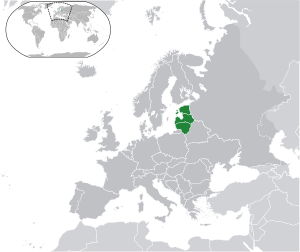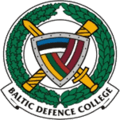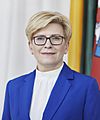Baltic states facts for kids
The Baltic states are three countries located in Northern Europe. They are found to the east of the Baltic Sea and south of the Gulf of Finland. These countries are Estonia, Latvia, and Lithuania, listed from north to south.
The languages spoken in these countries are quite different. People in Lithuania and Latvia speak Baltic languages, specifically Latvian and Lithuanian. However, Estonians speak an Uralic language called Estonian.
The Baltic countries share a lot of their culture and history with the Nordic countries. A big difference in their past is that the Baltic countries were taken over by the Soviet Union in 1940. This happened during the Second World War. The Nordic countries were not occupied by the Soviet Union, except for Karelia, a part of Finland that later became part of Russia. The three Baltic countries then became parts of the Soviet Union, known as the Estonian SSR, Latvian SSR, and Lithuanian SSR.
All three Baltic states became free again in 1991. This happened when the Soviet Union came to an end. The Baltic states believe that the Soviet occupation was against the law. Important groups like the United States, European Union, and United Nations agree with them. Today, the Baltic countries are among the most successful and modern countries that were once part of the Soviet Union. They joined the European Union and NATO in 2004. They also became part of the Schengen Area in 2007 and started using the euro currency by 2015.
Before most people in the Baltic countries became Christians during the Middle Ages, their main religion was Paganism. This old religion never completely disappeared. Some people still follow pagan beliefs today.
Images for kids
-
An improvised armoured train used in the Estonian War of Independence against Soviet Russia, 1919.
-
The 1939 Molotov–Ribbentrop Pact secretly divided the Baltic States into German and Soviet "spheres of influence."
-
A meeting of the Baltic Assembly at the Seimas Palace in Vilnius, Lithuania.
-
St. Olaf's church in Tallinn, Estonia.
-
Language families in Northern Europe.
-
St. Peter's Lutheran Church in Riga, Latvia.
-
The Catholic Church of St. Johns in Vilnius, Lithuania.
-
Gastilionys cliffs in Kauno Marios Regional Park near Kaunas.
-
The sand dunes of the Curonian Spit near Nida are Europe's highest moving sand dunes. It is a UNESCO World Heritage Site.
See also
 In Spanish: Países bálticos para niños
In Spanish: Países bálticos para niños


























